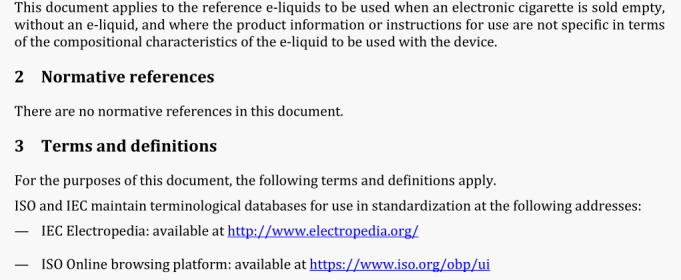Electronic cigarettes and e-liquids

BS EN 17375:2020 pdf free.Electronic cigarettes and e-liquids – Reference e-liquids.
This document specifes reference e-liquids to be used to test emissions generated by electronic digarettes [1].
This document apples to the reference e-lqulds to be used when an electronle cigarette Is sold empty,without an e-liquid, and where the product information or instructions for use are not specific in terms of the compositional characteristics of the e-liquld to be used with the device.
2 Normative references
There are no nomative references in this document.
3 Terms and definitions
For the purposes of this document, the fllowing terms and definitions apply.
IS0 and IEC maintain terminologlcal databases for use in standardization at the fllowing addresses:
一IEC Electropedia: available at htp://ww.clectropedia.ong/
一IS0 Online browsing platform: available at htps://ww.iso.ong/obp/ul
3.1 electronic cigarette product, that vapourises e-liquid to generate an inhalable aerosol carried by air drawn through the device by the user.
Note 1 to entry:Electronle cigarette is also referred to as e-clg. vapour product, vaping product, personal vapouriser or ENDS/ENNDS.
Note 2 to enty: Eletronic ciparette difere from tbacco products in that they do not contain tobacco.
3.2e-liquid base liquid, which may or may not contain nicotine and/or aditives, intended for transformation into an aerosol by an electronic cigarette
3.3 reference e-liquid e-liquid containing specific ingredients of a known quantity. to be used as a standard
4 Preparation and storage of reference e-liquids
4.1 General
The formulations of two reference e-liquids that shall be used within the scope of this document are given in Table 1.
4.2.1 Propylene glycol (CAS: 57-55-6), commonly termed (PG), shall comply with the following specific requirements:
NOTE These values are taken frorm the European Pharmacopeia Monograph. [2]
-purity: 99,5 % or higher;
-diethylene glycol: not more than 0,1 %.
4.2.2 Glycerol (CAS: 56-81-5), commonly termed vegetable glycerine (VG), shall comply with the following specific requirements:
NOTE These values are taken from the European Pharmacopeia Monograph [3]
purity: 98,0 % or higher;
一diethylene glycol: not more than 0,1 %;
一total impurities: not more than 0,5 %.
4.2.3 Nicotine or (S)-3-(1-methyl-2-pyrrolidinyI) pyridine (CAS: 54-11-5) shall comply with the following specific requirements:
NOTE These values are taken from the European Pharmacopeia Monograph. [4]
一purity: 99,0 % or higher;
一specific impurities:
一anatabine: not more than 0,3 %;
一B-nicotyrine: not more than 0,3 %;
一myosmine: not more than 0,3 %;
一nicotine -N-oxide: not more than 0,3 %;
一nornicotine: not more than 0,3 %;
一anabasine: not more than 0,3 %;
一unspecifed impurities: not more than 0,1 % each;
一total impurties: not more than 0,8 %.
4.2.4 Ethanol (CAS: 64-17-5) shall not be denatured and shall comply with the following specific
requirements:
NOTE
These values are taken from the European Pharmacopeia Monograph. [5]
purity: 95,0 % or higher;
methanol: not more than 200 ppm (v/v);
一acetaldehyde: not more than 10 ppm (v/v);
一benzene: not more than 2 ppm (v/v).
4.2.5 Water (CAS: 7732- 18-5) shall comply with the following specific requirements: ;
NOTE These values are taken from the European Pharmacopeia Monograph. [6]
一conductivity not greater than 5,1 uS/cm at 25 °C;
一nitrates: maximum 0,2 ppm;
一microbiological count less than 100 CFU/mL;
一total organic carbon or oxidisable substances: less than 0,5 mg/L.
4.3 Composition of reference e-liquids
4.3.1 To perform tests, there are two reference e-liquids (see 4.3.2 and 4.3.3) and their composition is described in 4.3.4.
4.3.2
A reference e-liquid, termed 70/30, which contains propylene glycol (PG) (4.2.1) and glycerol (vegetable glycerine) (VG) (4.2.2) in a ratio of 7:3 respectively.
4.3.3 A reference e-liquid, termed 50/50, which contains propylene glycol (PG) (4.2.1) and glycerol (vegetable glycerine) (VG) (4.2.2) in a ratio of 1:1 respectively.
4.3.4 The compositions of the reference e-liquids are detailed in Table 1. Masses are expressed in g per 100 g, and are not corrected for purity of the particular ingredient.
4.4 Storage of reference c-liquids
The maximum expiry date of the reference e-liquids is determined by the earliest expiry date of an individual ingredient.
Reference e-liquids shall be stored under conditions that prevent alteration of their compositions. It is recommended to store at a temperature between 5 °C and 25 °C, away from light sources, and in an airtight (preferably glass) container. Prior to use, the reference e-Iiquids shall be brought to ambient room temperature.
5 Use of reference c-liquids
5.1 Selection of reference c-liquid
Electronic cigarettes complying with the scope of this document shall be tested with one of the two reference e-liquids listed in Table 1. The manufacturer shall justify the choice made between the two reference e-liquids; as a guide low power devices would be better suited to using the e-liquid with PG/VG 70/30 ratio, and high power devices would be better suited to using the e-liquid with the PG/VG 50/50 ratio. The product information available to the consumer shall indicate which reference e-liquid was used for the emissions testing.
5.2 Period of use after opening
Reference e-liquids should be used within 24 h after opening if stored appropriately.
E-liquids are hygroscopic. Exposing opened containers of e-liquids to ambient atmosphere might change their compositions, so exposure of the reference e-liquids to ambient atmosphere should be minimized.BS EN 17375 pdf download.Electronic cigarettes and e-liquids